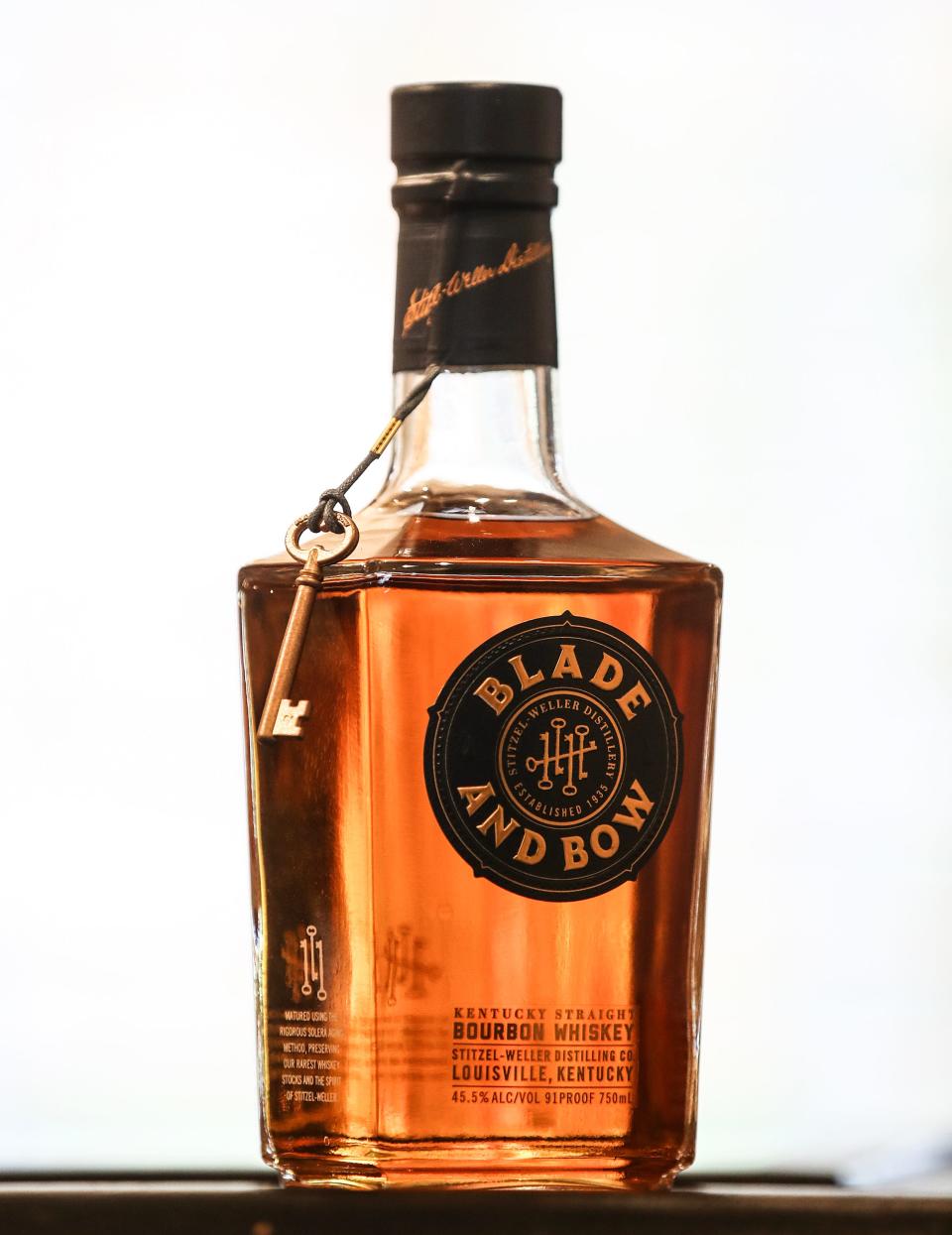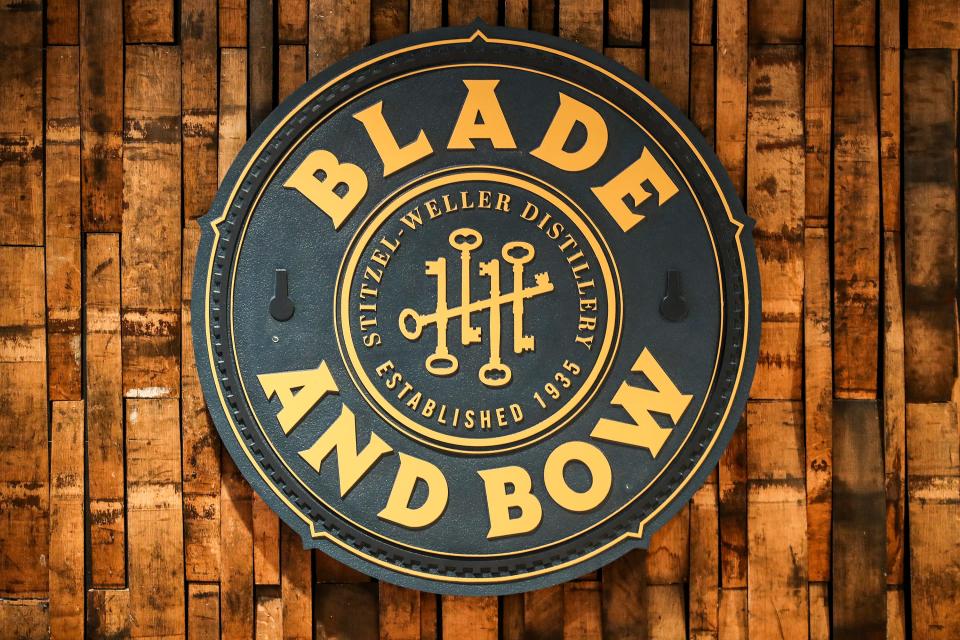Bourbon ghost town: Blade and Bow honors its heritage, makes coveted 22-year-old spirit
In one part of the historic Stitzel-Weller Distillery, you can sip on a mind-blowingly smooth pour of 22-year-old Blade and Bow in a refined modern bar.
In another, you can walk through a bourbon ghost town and witness a piece of the spirit industry’s late 20th-century downfall.
The Stitzel-Weller Distillery is a unicorn on the Kentucky Bourbon Trail. In addition to its celebrated Garden & Gun Club, cocktail classes, and an assortment of tours and tastings, Stitzel-Weller also pays homage to a very specific, albeit gloomy, part of bourbon’s legacy in Kentucky. When the distillery, which first opened in 1935, stopped production in 1992, workers walked out leaving tools out and aprons hanging on equipment, as if to say "Why bother?" For more than three decades these relics in the old barrel filling house and the distillery’s cooperage have created a strange sarcophagus for the industry’s downfall in the 1980s.
After the factory at 3860 Fitzgerald Road in Shively was acquired by spirits giant Diageo as part of a larger sale, it reopened to the public in 2014. Douglas Kragel, lead educator for Diageo's Accelerator Brands, told me the distillery has a responsibility to be a good steward of Stitzel-Weller's past as well as its future. Today the operation is home to brands Blade and Bow, I.W. Harper, and Orphan Barrel, but it also serves as a monument of sorts to the families, individuals, and brands, who made history there in the property's heyday.

But let’s be real, this is Kentucky. It’s also there to make really good bourbon.
Today the distillery makes about one barrel of bourbon each week rather than the numerous barrels that turned out once every four or so minutes at its historic peak of operation, Kragel said.
A collection of old bourbon barrels that were part of the acquisition and five keys link Blade and Bow to this historic property. Those old barrels from before the 1992 shutdown have been incorporated into the modern brand, whose name comes from the two distinct parts of a skeleton key.
Stitzel-Weller lore says when the distillery first opened on Kentucky Derby Day in 1935, following the repeal of American Prohibition, the owners hung the five keys to the distillery on the front door. Those keys were thought of as a symbol of hospitality intended to welcome the public to the grounds. Today, five keys appear on Blade and Bow's label, and each bottle also comes with a numbered key token. When Blade and Bow fans collect all five keys, they get their own engraved gold cup at the distillery. About 5,000 people have earned that honor.
This month the company is re-releasing its coveted Blade and Bow’s 22-year-old bourbon in honor of Bourbon Heritage Month. The company intends to bring it back every September until it's gone, Kragel told me, but there’s only so much of that old bourbon from the acquisition left. Bottles will be tough to find, but the distillery’s bar will have tastings of this rare spirit available for the public.
With that in mind, I recently spent some time with Kragel at Stitzel-Weller to better understand this bourbon’s roots in Kentucky's rich spirits history.
This interview has been edited for clarity and content.
How is the history and heritage of Stitzel-Weller reflected in Blade and Bow?

Doug Kragel: Blade and Bow is crafted around a place, not a person. I remember when it was in its inception stage and just watching everyone from the bottle design to the whiskey design soak in stories from this place and use it as a way to inspire them to create this whiskey. From the romantic side of things, I would say it is crafted by and designed around the history and stories of the facility and the story of the five keys.
Now the whiskey itself was also inspired by and crafted around history. When we first created and launched Blade and Bow, we wanted to find a way to preserve some of the last remaining bourbon that was distilled on-site at Stitzel-Weller that we had in our possession from before they shut down in 1992. We had this very old whiskey, and we had to find a way to innovate in order to create something that wasn't a limited release and that had longevity. It could be inspired by this place, but also build something off of this foundation for the future. That’s how they landed on using a blending and mingling system called the Solera Method (for Blade and Bow.) … This tiered fractional blending system is not just helping us preserve old whiskey, but it's also creating a huge depth of character and complexity in what's coming out in the actual whiskey itself.
What is the story of the five keys?

Kragel: So when the distillery opened Derby Day 1935, they hung five keys in the front door of that facility and they were a symbol of the five steps to making great whiskey: grains, yeast, fermentation, distillation, and maturation.
The magical part about it was that this was also a symbol of hospitality within the bourbon industry. Every morning, they would take those keys and they would unlock the door, and then they would hang the keys in the front of the door as a symbol that they were open.
But it's even more than that because it was a symbol of trust and a symbol of welcoming and just overall understanding that if you see these keys here ― you can come in and please do. This was at a time before bourbon tourism was anything in the industry.
How do you see those five principles reflected in the modern campus?

Kragel: Hospitality is one of the core pillars of what we do at Stitzel-Weller. From the tourism portion of it to the cocktails, and the service that we give upstairs [in the Gun and Garden Club] just making everyone feel welcome. So that's a huge part of what we do on campus and how we bring that back to the world, while still giving people a slightly nontraditional version of experiencing the Bourbon Trail.
When we get to our moments of “what are the foundations of making whiskey,” it's really straightforward. I think from our small-scale still operation to kind of the linear way in which we walk you through the steps of making whiskey. I think that the idea of saying that these five keys represented the five steps of making great whiskey is such an amazing and easily digestible way of telling people what bourbon is all about.
Features columnist Maggie Menderski writes about what makes Louisville, Southern Indiana and Kentucky unique, wonderful, and occasionally, a little weird. Sometimes she writes about bourbon, too. Reach Maggie at [email protected] or 502-582-4053. Follow along on Instagram and Twitter @MaggieMenderski.
This article originally appeared on Louisville Courier Journal: Stitzel-Weller Distillery is home to history, Blade and Bow bourbon